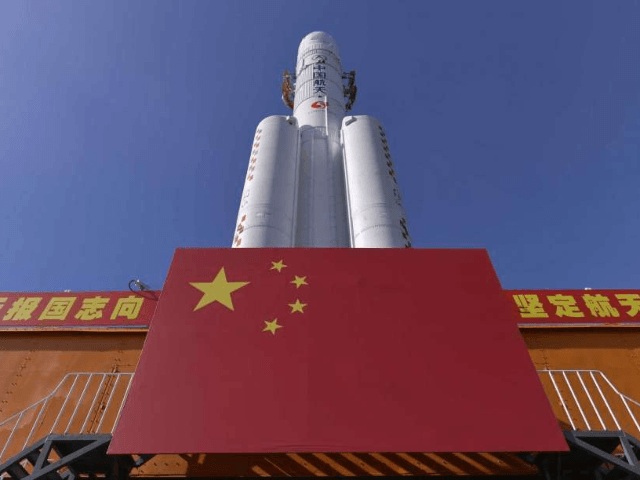Chinese dictator Xi Jinping on Thursday touted advances in the “great socialist cause” over the past century, including the “War to Resist U.S. Aggression and Aid Korea” – i.e. the Chinese military intervention that unleashed the inhuman evil of the North Korean Communist regime upon the people of Korea and the world – and culminating in China’s launch of an unmanned mission to Mars.
Meanwhile, southern China remains submerged in floodwater and nervous residents wonder if the huge Three Gorges Dam can withstand the stress from the swollen Yangtze River.
Xi journeyed to northeastern China for a pleasant day of inspecting farm production before visiting the military memorial in Siping, which commemorates an exceptionally bloody 1946 battle between China’s Communists and Nationalists that the Communists actually lost after sending thousands of conscripts to die in human wave attacks.
The Communists survived this defeat in part because U.S. Secretary of State General George C. Marshall negotiated a ceasefire. The Communists made a comeback later and were ultimately able to drive the Nationalists onto the island that became modern Taiwan.
Needless to say, there was not much gratitude for that timely rescue from America in Xi’s remarks at Siping, which the Chinese Communist Party (CCP) simply treats as the location of a hard-fought victory in the “Chinese People’s War of Liberation.”
“We must keep firmly in mind that New China did not come easily,” Xi said at the memorial – a sentiment Gen. Marshall would probably agree with, for entirely different reasons.
China’s state-run Xinhua news service rhapsodized at length about Thursday’s launch of a Long March-5 rocket bound for Mars with an orbiter, landing module, and surface rover on board. The rocket should arrive at its destination in about seven months, taking advantage of the same ideal launch window the United Arab Emirates employed to send its own mission to Mars on Sunday.
Xinhua explored the poetry behind the name of the project, “Tianwen,” the title of an ancient poem that asked “questions to Heaven”:
The triple-task expedition of Tianwen-1 marks another milestone in China’s aerospace science and technology development, as well as a fresh daring adventure in the country’s long march of outer space exploration following its lunar program and the endeavor to build a space station.
Looking up into the starlit sky, the human race has had a long-standing obsession with Mars. It is now widely known that Mars and Earth, both with warm temperatures, thick and wet atmospheres around the surface, are like twin brothers who have grown apart. Scientists always have a strong interest in exploring this planetary sibling to discover secrets of the origin of life, and decode more mysteries of the vast universe.
Xinhua then scolded the United States for “seeking to distort its purpose of developing space science and technology, demonizing the country’s exploration programs as a display of ambition to challenge America’s leadership in space, and to conquer what many call the final frontier of humanity.”
The Chinese state news service found this churlish American attitude especially puzzling because there are so many movies about everybody working together with China to explore space, such as The Martian with Matt Damon and The Wandering Earth, a Chinese film about blasting the Earth off into the depths of space on a 2,000 year journey to escape the dying Sun.
While the Chinese government turns its eyes to Mars, the southern part of the country is still suffering from once-in-a-century floods, with historic water levels recorded in 33 rivers and 400 more well over the danger line.
The Guang-Xi regional dam collapsed on Wednesday, overwhelmed by floodwaters despite its 195,000 cubic meter capacity. Thousands of smaller dams are in danger, threatening a cascade that would threaten the vital Three Gorges Dam, the largest hydroelectric facility in the world.
India’s WION News worried that China’s dams are strategic cards that are “failing before China even has a chance to play them, including some badly weakened structures that date back to the Mao Zedong era.”
WION said the crisis at Three Gorges is real, but “China is in denial” because it insists the dam can handle more floodwater, even after quietly admitting that the structure has “deformed slightly” under the pressure. Some Chinese officials still maintain the Three Gorges dam will last for another 500 years.
“China managed to hide the dam collapse at Guang-Xi and it was not half as big the Three Gorges Dam. The Three Gorges Dam is a very big deal and saving it is a matter of national prestige with authorities now neck-deep in trouble,” WION wrote.
Nikkei Asian Review (NAR) noted on Thursday that the level of the Yangtze River now exceeds 162 meters, but the Three Gorges Dam was only built to hold 145 meters of water. The inflow of water to the dam since last weekend is at least twice the amount its controllers have released in controlled discharges.
A huge number of lives are at stake in the area that will flood if the Three Gorges Dam is overwhelmed, and NAR noted a number of major foreign corporations have plants in the area, including Japan’s Honda, Isuzu, and Mazda automakers and the Bridgestone tire company. Some of these factories only recently returned to full capacity after shutting down for the coronavirus outbreak.

COMMENTS
Please let us know if you're having issues with commenting.